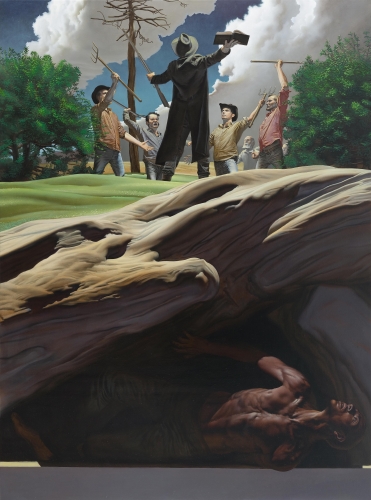Biography
Nicola Verlato is a painter, sculptor, architect and musician born in Verona on February the 19th, 1965.
He studied painting in the studio of an elderly friar in a monastery from the age of 9 to 14.
He studied lute and composition at the conservatories of Verona and Padua.
He studied architecture at the University of Venice.
Among the numerous exhibition occasions, the Italian Pavillion at the 53rd Venice Biennale in 2009, the Prague and Tirana Biennials in 2001, 2003 and 2004, the Rome Quadrennial in 1996 and 2008, the exhibitions at the Royal Palace in Milan, the PAC and the MART, the National Museum of Stockholm, and National Fine Arts Museum of Helsinki, the Nuit Blanche of Toronto, the Akron Museum , the White Columns of New York, National Museum in Rome at Terme di Diocleziano, National Museum in Matera-Palazzo Lanfranchi.
His work is represented by Postmasters Gallery New York-Rome, and Morten Poulsen Gallery Copenhagen, Isabel Croxatto in Santiago- Chile, and Giovanni Bonelli Galleria in Milan.
His works are present in the collections of the MART Museum in Rovereto, the George Lucas Museum in Los Angeles, and Musac in Salamanca.
After 14 years in Venice, 7 in Milan, 7 in New York, and 7 in Los Angeles he now resides in Rome.
Nicola Verlato is known for his emotionally engaging figurative paintings and sculptures. To further enhance his imagery, he employs a sophisticated process that combines classical techniques with modern technologies such as 3D modeling programs like Maya and Zbrush. The preparatory drawings for Nicola Verlato's symbolic and highly illusionistic paintings have intrinsic value, much like those of past masters, foremost among them Raphael. Unlike the great Renaissance master, Verlato's issue is more complex; the painter today potentially has access to a range of sources and techniques for image creation. The reference to Raphael is not coincidental; Verlato, like other colleagues, indeed harbors a strong passion for Renaissance art. It is undeniable that both share a strong permeability towards the contemporary visual imagery, from which they can grasp images, ideas, and even the rudiments of a style: versatile towards other authors, they grasp their formal characteristics to then transform and make them unmistakably their own. Like Verlato's, Raphael's art is idealizing, in which natural appearances must be corrected by the artist according to a certain idea of beauty.
Verlato is a great equalizer. In his capable blender, he mixes the categories of the sublime and the trivial without dismay - established by an elite, as if by divine command. In his latest project, the artist aspires, in his own words, to "distill a metaphysics" from the subculture of skateboarding, heavy metal, and pornography. His drawings and paintings, which largely depict the human body caught in violent motion and rendered in a way that creates an illusionistic effect, can almost inevitably be read as sexual themes.


